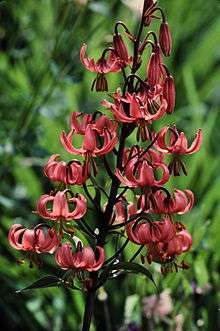Lilium martagon
| Lilium martagon | |
|---|---|
 | |
| Scientific classification | |
| Kingdom: | Plantae |
| (unranked): | Angiosperms |
| (unranked): | Monocots |
| Order: | Liliales |
| Family: | Liliaceae |
| Genus: | Lilium |
| Species: | L. martagon |
| Binomial name | |
| Lilium martagon L. | |
| Synonyms[1] | |
|
Synonymy
| |
.jpg)
Lilium martagon (martagon lily[2] or Turk's cap lily) is a Eurasian species of lily. It has a widespread native region extending from Portugal east through Europe and Asia as far east as Mongolia.[1][3][4][5][6][7][8][9]
- Varieties
Numerous names have been proposed at the levels of subspecies and varieties. Only two are recognized by the World Checklist.[1]
- Lilium martagon var. martagon - from Portugal to Mongolia
- Lilium martagon var. pilosiusculum Freyn - Russia, Kazakhstan, Xinjiang, Mongolia
Cultivation
Horticulturally it is in Division IX (true species). It is stem-rooting, growing between 1 metre (3 ft 3 in) and 2 metres (6 ft 7 in) tall. The flower colour is typically a pink-purple, with dark spots, but is quite variable, extending from near white to near black. The flowers are scented. Numerous flowers are borne on each plant, and up to 50 can be found on vigorous plants. The green stems can be flushed with purple or red and the leaves are elliptic to inverse lanceolate, mostly in whorls, up to 16 centimetres (6.3 in) long and often lightly hairy underneath.[10][11]
This plant[12] and the white form 'Album'[13] have gained the Royal Horticultural Society's Award of Garden Merit.
Lilium martagon was used in hybridising with L. hansonii at the end of the 19th century by Mrs RO Backhouse of Hereford, England.[14]
Name
The name Turk's cap lily, also applied to a number of other species, comes from the characteristic reflexed shape of the petals. The specific epithet martagon is a Turkish word which also means turban or cap.[15]
It is also named as Lily of Istanbul or Sultan Lily or Dragon Lily.
Toxicity
Cats
Lilium martagon, like many in the genus, is highly toxic to cats and ingenstion often leads to fatal renal failure;[16][17][18] households and gardens which are visited by cats are strongly advised against keeping this plant or placing dried flowers where a cat may brush against them and become dusted with pollen which they then consume while cleaning.[19] Suspected cases require urgent veterinary attention.[20] Rapid treatment with activated charcoal and/or induced vomiting can reduce the amount of toxin absorbed (this is time-sensitive so in some cases vets may advise doing it at home), and large amounts of fluid by IV can reduce damage to kidneys to increase the chances of survival.[20]
References
- 1 2 3 "World Checklist of Selected Plant Families: Royal Botanic Gardens, Kew".
- ↑ "BSBI List 2007". Botanical Society of Britain and Ireland. Archived from the original (xls) on 2015-02-25. Retrieved 2014-10-17.
- ↑ Altervista Flora Italiana, Giglio a turbante, Common Turk's Cap Lily, Lilium martagon L. includes many color photos plus European distribution map
- ↑ Flora of China, Vol. 24 Page 137 新疆百合 xin jiang bai he Lilium martagon var. pilosiusculum Freyn, Oesterr. Bot. Z. 40: 224. 1890.
- ↑ Tutin, T.G. & al. (eds.) (1980). Flora Europaea 5: 1-452. Cambridge University Press.
- ↑ Davis, P.H. (ed.) (1984). Flora of Turkey and the East Aegean Islands 8: 1-632. Edinburgh University Press, Edinburgh.
- ↑ Czerepanov, S.K. (1995). Vascular Plants of Russia and Adjacent States (The Former USSR): 1-516. Cambridge University Press.
- ↑ Grubov, V.I. (2001). Key to the Vascular Plants of Mongolia 1: 1-411. Science Publishers, Inc. Enfield, USA. Plymouth, U.K..
- ↑ Ikinci, N., Oberprieler, C. & Güner, A. (2006). On the origin of European lilies: phylogenetic analysis of Lilium section Liriotypus (Liliaceae) using sequences of the nuclear ribosomal transcribed spacers. Willdenowia 36: 647-565.
- ↑ Christopher Brickell (1996). The RHS Encyclopedia of Garden Plants. London: Dorling Kindersly. p. 615. ISBN 0-7513-0436-0.
- ↑ European Garden Flora, 1986.
- ↑ "RHS Plant Selector - Lilium martagon". Retrieved 21 May 2013.
- ↑ "RHS Plant Selector - Lilium martagon 'Album'". Retrieved May 21, 2013.
- ↑ Andrew Mikolajski, The New Plant Library - Lilies, Lorenz Books, Anness Publishing Ltd, New York, 1998, p10, ISBN 1-85967-634-0
- ↑ Allen J Coombes (1985). The Hamlyn Guide to Plant Names. Reed International Books. p. 118. ISBN 0-600-57545-4.
- ↑ Frequently Asked Questions No Lillies For Cats.
- ↑ Lily toxicity in the cat. Kevin T. Fitzgerald, PhD, DVM, DABVP.
- ↑ Turk's cap lily is pure delight The Guardian.
- ↑ The Valentine bouquet that killed my cats: Mother's Day warning on lethal lilies Daily Mail.
- 1 2 Lily Poisoning in Cats. Pet MD.
| Wikimedia Commons has media related to Lilium_martagon. |